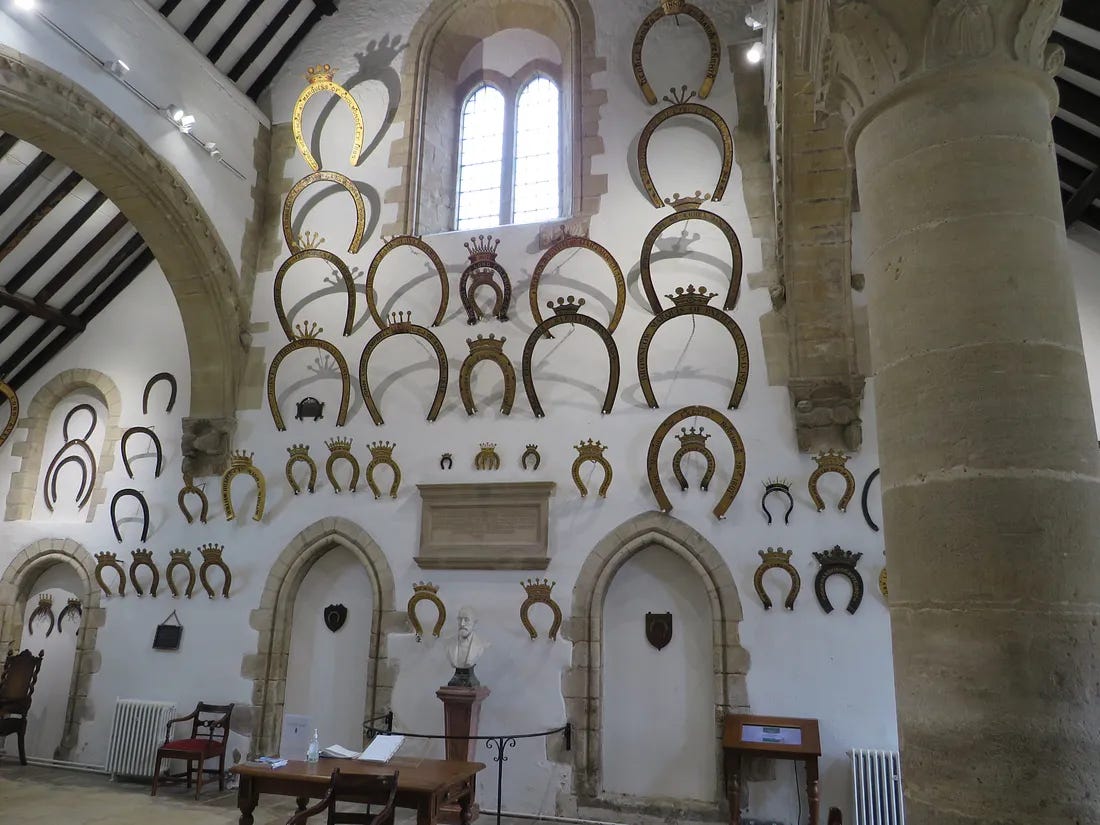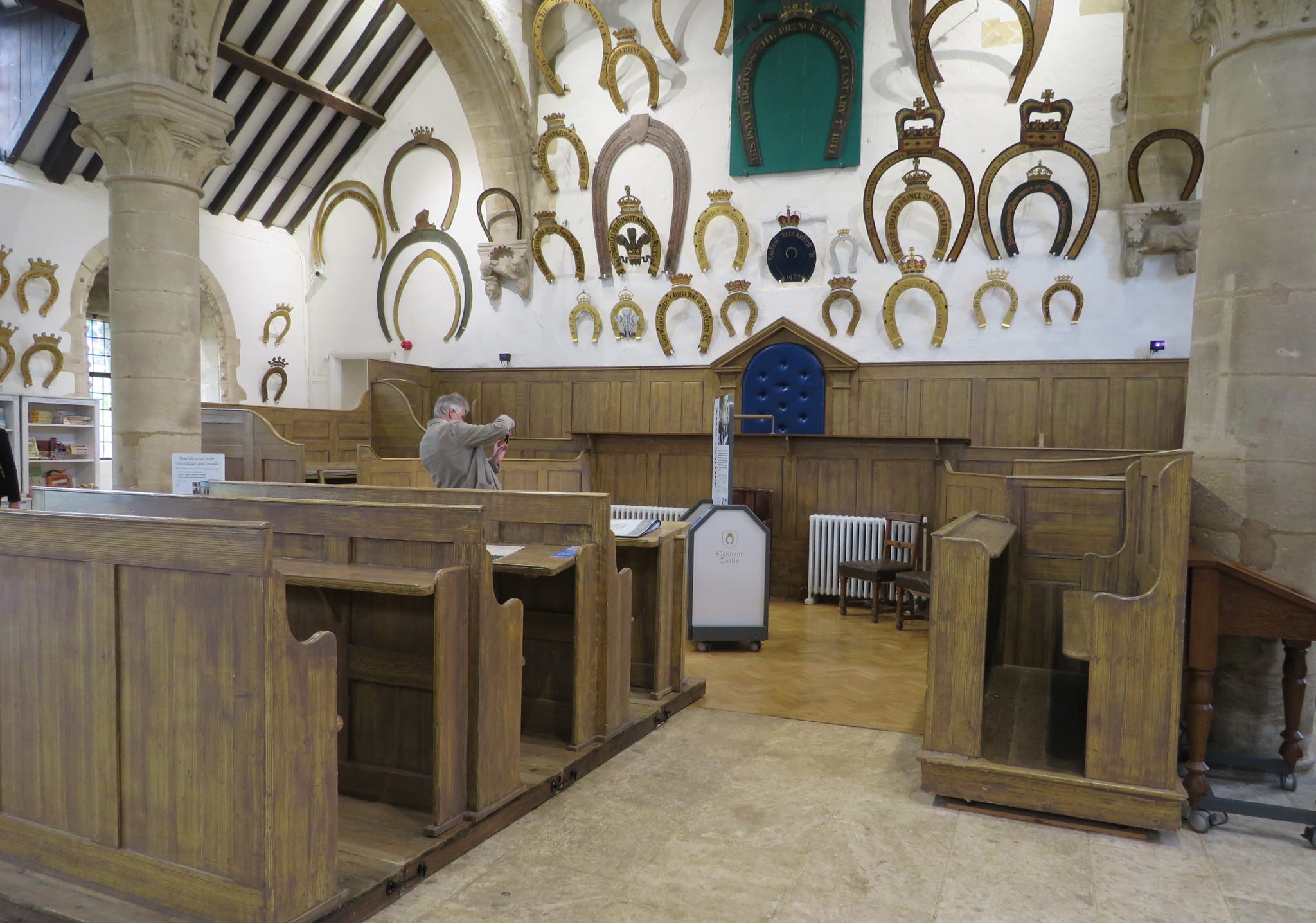
Oakham, a market town in the English county of Rutland, boasts a well-preserved Great Hall within its dilapidated castle walls, and an amazing collection of oversized horseshoes, some gilded and bearing coronets.
After the successful conquest of England by the Norman-French in 1066, the existing manorial lands were redistributed to the new King William’s subordinate nobility and knights.
These gifts for loyal military service provided both a living and ensured control of a belligerent British population. Using forced labour, a net of earthen motte and bailey castles sprang up every ten miles so one would never be far from reinforcements.
Oakham Manor, once part of the dowry of Anglo-Saxon Queens, was gifted to the de Ferrières family (now written as de Ferrers). By 1180 the family had the financial resources to build in stone, and felt so secure that the usual towers and castellated battlements were left for the curtain wall.
The rectangular Great Hall was built free-standing in the centre of the two-acre inner bailey, surrounded by its ancillary buildings which have not survived. The Hall, however, remains one of the best examples of Norman domestic architecture in the country, mostly due to its horseshoes and its role as a court of justice.

The de Ferrers came from an area in Normandy known for its iron-working - consider the words ‘farrier’ and ‘ferrous’ metals - so it can be no mere chance that the family was gifted land rich in ironstone deposits. During the Medieval era, he who controlled iron, controlled. Period.
A later sketch of a 1205 seal belonging to Henry de Ferrers shows six horseshoes on a heart-shaped, or perhaps halter-shaped, ground.
There is no document from the time of the de Ferrers mentioning a horseshoe tribute, but later writings consider the custom “longstanding”.
The earliest known mention is in a survey of the lands and property of Edward Stafford, 3rd Duke of Buckingham, after he had been executed for treason by King Henry VIII in 1521:
“…no nobleman to pass through the said lordship [unless] he do homage to the castle there in giving an horse shoe…”
Did the demanding of a horseshoe tribute begin as friendly rivalry? Was it a dare? It sounds as if a snub embraced and enlarged over good food and copious alcohol.

However, a mere horseshoe nailed to the castle gate or the door of the Great Hall was raised to a whole new level in 1470 during the ‘Civil Wars’, which became known to British history as the Wars of the Roses.
Close to the castle, on the Great North Road (now the A1) between the villages of Empingham and Tickencote, King Edward IV, older brother to the later King Richard III, routed stronger rebel numbers by the use of cannon, probably a type of bombard. It is likely the mustered rebels, ordinary farm-folk in the main, had not seen one in action, never mind being on the receiving end of a battery. Those who were able to fled after the first volley.
Returning victorious to Oakham, Edward decreed a wrought-iron horseshoe worthy of the event be hung inside the Hall behind the high table. Decorated with roses outlined in black on a red background, it stands at nearly five feet tall. In a good light, traces of its original colour can still be discerned.

What a king decrees, his peers of the realm – dukes, marquesses, earls, viscounts, bishops and lowly barons – are keen to follow, all marking their “tribute” so theirs cannot be mistaken.
Some are known to have been lost, and there is a question over horseshoes from Elizabeth I’s reign (1558-1603) being melted down for armaments during World War 1, but over 200 survive, including horseshoes from royals down the centuries.
Queen Victoria paid her tribute while still a princess in 1835, and not even World War 2 stopped King George VI, father to the late Queen Elizabeth II, presenting his in 1944.
Today, the horseshoes cover the white-washed inner walls of Oakham Castle’s Great Hall, creating an impressive backdrop to the many weddings celebrated there.

The horseshoes also form the fierce countenance of History glaring down at the accused during a now bi-annual sitting of the Crown Court, a judicial process which began at the castle in 1229 as a Session of Assize.
For information on a more glamourous Medieval castle which started life as a mere motte & bailey stronghold, see Leeds Castle: Six Royal Queens and an American Heiress.
Sources: Personal visit, Oakham Castle’s visitor guide and digital timeline.
Various Wikipedia and other digital pages.
Regards for now, Linda



